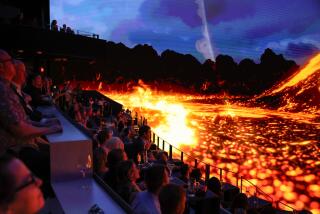Big Screen Furor-Rama in Hollywood
To a generation of moviegoers, the Cinerama Dome at Sunset Boulevard and Ivar Avenue in Hollywood was a Los Angeles cultural landmark, its quirky, geodesic-shaped theater a place where one could see wide-screen movies as they were meant to be seen, and a place that helped inspire filmmakers entranced by movies like Steven Spielberg’s “Close Encounters of the Third Kind.”
But now, just as Cinerama’s unique method of movie projection is about to celebrate its 50th anniversary, a debate is raging in Hollywood over plans by the dome’s owners to install a new giant curved screen that critics guarantee will make Cinerama movies, as well as many conventional ones, appear out of focus.
Only in Hollywood, with its heavy concentration of film industry professionals and serious movie buffs, could the design of a movie screen provoke such concern, and even outrage.
In March, Pacific Theatres Corp. plans to reopen a refurbished Cinerama Dome after a multimillion-dollar face lift that began after the theater was closed in the summer of 2000.
The project is not far from Hollywood’s other major redevelopment projects of recent years--the El Capitan Theater and the new Hollywood and Highland mall, where the Kodak Theater will play host March 24 to the Academy Awards.
With its New York World’s Fair-style design, the 250,000-square-foot Cinerama Dome site will include retail shops, a 24-hour health club and a seven-level, 1,750-space parking structure that cost $32 million.
An additional 14 theaters will be built at the site. Although Hollywood is home to a handful of historic theaters--Grauman’s Chinese and the El Capitan--the area is considered “underscreened” compared to other neighborhoods.
It was the public’s long-standing affection for Cinerama that persuaded Pacific Theatres and the Los Angeles Community Redevelopment Agency to restore “three-projector” or “three-strip” Cinerama movies at the dome as part of a $100-million-plus renovation now underway.
Joined by local preservationists in their crusade, industry observers and film buffs complain that despite the expenditure of millions of dollars on the project, movies at the new Cinerama Dome will have the same visual distortions that plagued the old dome for many years.
They are frustrated that Pacific Theatres, which has roots in Southern California dating to 1946 and has owned the rights to Cinerama since the early 1960s, has decided to install a solid-sheet screen in the refurbished theater rather than a louvered screen like the one that graced the dome when it opened in 1963 and remained there for a decade.
They fear that if Pacific Theatres uses a solid-sheet screen, it will create the same focus problems that caused movies in the old dome to appear washed out as a result of light bouncing from one side of the deeply curved screen to the other.
Conflict of Image vs. Sound System
“It’s sad,” said Robert W. Nudelman, director of preservation issues for Hollywood Heritage, a group dedicated to preserving Hollywood’s past. “They spent a bundle putting that all together. Then they get to the 5-yard line and fumble the ball.”
But the conflict appears to pit a vintage film technology against today’s state-of-the-art sound systems. Pacific Theatres says its massive new sound system would cause movement in the screen’s louvers, which also could distort the projected image.
Although the Cinerama Dome has been a mecca for fans wanting to see wide-screen movies, there was a certain irony to the fact that it never actually screened any of the classic three-projector Cinerama movies. The 1962 epic “How the West Was Won,” for example, was shown at the old Warner Cinerama Hollywood.
By the early 1960s, Hollywood came to favor one-projector, wide-screen formats like CinemaScope, Todd-AO and VistaVision. The first movie to premiere at the dome was the 1963 madcap ensemble comedy “It’s a Mad, Mad, Mad, Mad World,” which was hyped as Cinerama but was actually filmed in single-camera Ultra Panavision 70.
Only a few classic, three-projector Cinerama films were ever made. They include “How the West Was Won,’ the 1962 fairy tale adaptation “The Wonderful World of the Brothers Grimm” and a handful of travelogues. There aren’t any new Cinerama features in the works.
Still, there was something about seeing movies at the Cinerama Dome that could draw large crowds. When the theater closed for repairs two summers ago, throngs of fans turned out for a special final weekend of screenings of “Ben-Hur,” “Lawrence of Arabia” and “Terminator 2: Judgment Day.”
“There were people out in the street smacking each other around trying to get tickets,” said film editor Jack Tucker. “This is an example of how much people care about this theater. Pacific seems to think this is just another theater. To me, it’s almost a holy place.”
Pacific executives say they are passionate about Cinerama and remain fully committed to building the finest theater venue possible to showcase it, one that will not only screen original three-projector Cinerama movies, but also offer today’s wide-screen films while restoring the tattered theater complex to the glamour of its heyday.
“We’ve really gone to all efforts to make sure we can bring back the majesty of the original building,” said Nora Dashwood, chief of theater operations at Pacific Theatres, which operates about 450 screens in California and Hawaii.
When asked whether she could guarantee that the films shown in the renovated dome will be crystal clear, Dashwood replied: “I guarantee we will have a clear presentation, which has to be in order for it to be a top-grossing and favorite place to go see a movie.”
Taking Pains to Restore Projection Booth
To that end, the owners are dusting off the projectors and restoring the projection booth just so it can have three projectors for Cinerama. Warner Bros. is also restoring MGM’s “How the West Was Won” while Pacific is restoring the original Cinerama feature, the 1952 “This Is Cinerama.”
In conventional filmmaking, movies are shot with a single camera equipped with a single lens, then projected onto a screen with one projector.
Three-strip Cinerama required the use of a single camera outfitted with three lenses and three separate negative elements, and it was shown in theaters by using three projectors.
One of the key features of the new Cinerama Dome will be the use, at long last, of all three projection booths, which were originally designed to show Cinerama movies in all their breathtaking sweep.
Under a 1998 agreement reached between Pacific Theatres and the Community Redevelopment Agency, which are partners in redeveloping the site, Pacific agreed to retain the curved screen. However, the agreement makes no mention of what type of screen Pacific would install.
To get around the visual distortions inherent in a curved screen, early Cinerama movies were projected onto louvered screens, which consisted of a series of perforated vertical strips.
Until last fall, Pacific Theatres had indicated it would install the signature louvered screen. But the controversy places today’s film exhibition technology at odds with the process invented back when Harry Truman occupied the White House.
‘Bunch of Little Black Scratches’
A key reason Pacific executives have decided against installing a louvered screen is the state-of-the-art sound system envisioned for the dome.
If the sound causes too much vibration, Dashwood said, the vertical lines between the strips of a louvered screen can appear like a “bunch of little black scratches” to the audience because the strips are moving.
“Our experts came back and said, ‘You cannot put this stripped screen in front of the sound systems of today and not expect movement to go along with it,’ ” Dashwood said. “They’ve tried different things. They tried to see if they could put fish line through them to kind of hold them in place. Velcro them. To date, there just hasn’t been a solution that we feel confident in.”
Enthusiasts Seek to Pressure Owners
But that argument doesn’t wash with critics, who say louvered screens work well if the vertical strips are properly braced.
Pacific’s decision to use a solid screen, critics say, won’t solve anything because stretching a solid white sheet across a curved surface creates “belly sag” in the center of the screen, making it difficult for a projectionist to achieve proper focus.
“We know it didn’t work before, so why would it work now?” film editor Doug Haines said of the solid-sheet screen. “We are not telling them to make some sort of huge investment to make some perfect theater so that, in our fantasies, it would be the greatest theater in the world. Just make it acceptable so it doesn’t look horrible.”
Film buffs are so concerned about getting Cinerama right at the dome that they are marshaling their forces, hoping to pressure Pacific Theatres into changing its stance.
To that end, organizations representing Hollywood editors and cinematographers, as well as individuals such as Sam Raimi, director of this summer’s comic book action film “Spider-Man,” and Allen Daviau, the cinematographer on Spielberg’s “E.T.: The Extra-Terrestrial,” have written letters of concern to Pacific Theatres.
Former studio executive Laura Ziskin, who is producing this year’s Academy Awards show and Raimi’s “Spider-Man,” urged the theater chain in a letter dated Jan. 18 to “finally resolve the image problems that have long plagued the historic venue.”
But Dashwood said she is confident that when the theater reopens, audiences will sit down and their “jaws will drop and they’ll say, ‘Oh, my gosh, this is just terrific!’ ”
She also dismisses criticism that Pacific might be going with the solid screen simply to cut costs. A solid screen, she said, costs $25,000--a drop in the bucket compared with the overall renovation costs at the theater--and a louvered screen would add only $20,000 more.
But even if new audiences thrill to Cinerama, there is no way today’s audiences can ever relive what it was like when their parents and grandparents first experienced the wonder of seeing a Cinerama movie in its infancy.
Narrated by broadcaster and adventurer Lowell Thomas, “This Is Cinerama” made its debut Sept. 30, 1952, at the Broadway Theater in New York and went on to become the highest-grossing film of the year.
There was never a need to rush out and see a Cinerama movie for fear that it would quickly be pulled by the exhibitor as so many movies are today.
“This Is Cinerama” played for three years without a break, and “How the West Was Won” played for about two years.
More to Read
Only good movies
Get the Indie Focus newsletter, Mark Olsen's weekly guide to the world of cinema.
You may occasionally receive promotional content from the Los Angeles Times.










